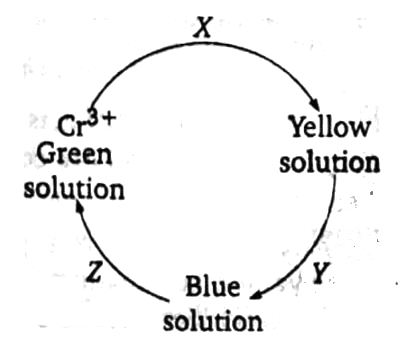A hydrated solid X on heating initally gives a monohydrated compound Y. Y upon heating above 373 K leads to an anhydrous white powder Z, X and Z respectively, are:
Baking soda and soda ash
Washing soda and dead burnt plaster
Baking soda and dead burnt plaster
Washing soda and soda ash
The correct Answer is:D
To solve the problem, we need to identify the hydrated solid X, the monohydrated compound Y, and the anhydrous white powder Z based on the heating process described.
1. Identify the Hydrated Solid (X):
- The problem states that we have a hydrated solid X that on heating gives a monohydrated compound Y. A well-known hydrated compound that fits this description is washing soda, which is sodium carbonate decahydrate (Na2CO3·10H2O).
2. Heating X to form Y:
- When washing soda (Na2CO3·10H2O) is heated, it loses water molecules. The first stage of heating results in the formation of a monohydrated compound, which is sodium carbonate monohydrate (Na2CO3·H2O). This is our compound Y.
3. Heating Y to form Z:
- The next part of the question states that Y (Na2CO3·H2O) upon further heating above 373 K leads to an anhydrous white powder Z. When sodium carbonate monohydrate is heated above 373 K, it loses the remaining water molecule and forms anhydrous sodium carbonate (Na2CO3), which is the white powder Z.
4. Conclusion:
- Therefore, we can summarize the compounds as follows:
- X (hydrated solid) = Na2CO3·10H2O (Washing Soda)
- Y (monohydrated compound) = Na2CO3·H2O (Sodium Carbonate Monohydrate)
- Z (anhydrous white powder) = Na2CO3 (Soda Ash)
Final Answer:
- X = Washing Soda (Na2CO3·10H2O)
- Y = Sodium Carbonate Monohydrate (Na2CO3·H2O)
- Z = Soda Ash (Na2CO3)
- The problem states that we have a hydrated solid X that on heating gives a monohydrated compound Y. A well-known hydrated compound that fits this description is washing soda, which is sodium carbonate decahydrate (Na2CO3·10H2O).
- When washing soda (Na2CO3·10H2O) is heated, it loses water molecules. The first stage of heating results in the formation of a monohydrated compound, which is sodium carbonate monohydrate (Na2CO3·H2O). This is our compound Y.
- The next part of the question states that Y (Na2CO3·H2O) upon further heating above 373 K leads to an anhydrous white powder Z. When sodium carbonate monohydrate is heated above 373 K, it loses the remaining water molecule and forms anhydrous sodium carbonate (Na2CO3), which is the white powder Z.
- Therefore, we can summarize the compounds as follows:
- X (hydrated solid) = Na2CO3·10H2O (Washing Soda)
- Y (monohydrated compound) = Na2CO3·H2O (Sodium Carbonate Monohydrate)
- Z (anhydrous white powder) = Na2CO3 (Soda Ash)
- X = Washing Soda (Na2CO3·10H2O)
- Y = Sodium Carbonate Monohydrate (Na2CO3·H2O)
- Z = Soda Ash (Na2CO3)
Topper's Solved these Questions
- JEE MAIN REVISION TEST - 13BOOK - VMC MODULES ENGLISHCHAPTER - JEE MAIN REVISION TEST - 13EXERCISE - CHEMISTRY (SECTION 2)
5 Videos
- JEE MAIN REVISION TEST - 12 BOOK - VMC MODULES ENGLISHCHAPTER - JEE MAIN REVISION TEST - 12 EXERCISE - CHEMISTRY
25 Videos
- JEE MAIN REVISION TEST - 18BOOK - VMC MODULES ENGLISHCHAPTER - JEE MAIN REVISION TEST - 18EXERCISE - CHEMISTRY - SECTION 2
5 Videos
Similar Questions
Knowledge Check
A white solid X on heating gives a white solid Y and an acid gas Z. gas Z is also given out when X reacts with an acid. The compound Y is also formed if caustic soda is left open in the atmosphere. X, Y and Z are
AX−NaHCO3,Y−Na2CO3,Z−CO2BX−Na2CO3,Y−NaOH,Z−CO2CX−Na2CO3,Y−NaHCO3,Z−CO2DX−NaOH,Y−NaHCO3,Z−CO2A metal X reacts with water to produce a highly combustible gas Y, and a solution Z. another metal P reacts with Z to give the same gas Y. X,Y,Z and P respectively are
AZn,H2,Zn(OH)2,AlBNa,H2,NaOH,ZnCK,H2,KOH,AlDLi,H2,LiOH,K
Reaction of an inorganic sulphite X with dilute H2SO4) generates compound Y . Reaction of Y with NaOH gives X . Further , the reaction of X and Y and water affords compound Z . Y and Z respectively are :
View SolutionAn orange solid (X) on heating, gives a colourless gas (Y) and a only green residue (Z). Gas (Y) on treatment with Mg, produces a white solid substance……
View Solution
X,Y and Z in the above graph are
View SolutionB2H6+NH3→Addition compound (X) 450K−−→ Y+Z(g)
In the above sequence Y and Z are respectively :
View SolutionA colourless water soluble solid (X) on heating gives equimolar quantities of (Y) and (Z). Y gives dense white fumes with HCl and Z does so with NH3. Y gives brown ppt. with K2HgI4 (Nessler's reagent) and Z gives white precipitate with nitrates of Ag+,Pb2+andHg+. What is X ?
View SolutionA colourless water soluble solid (X) on heating gives equimolar quantities of (Y) and (Z). Y gives dense white fumes with HCl and Z does so with NH3. Y gives brown ppt. with K2Hgl4 (Nesslers reagent) and Z gives white precipitate with nitrates of Ag+,Pb2+andHg+. What is X ?
View Solution

